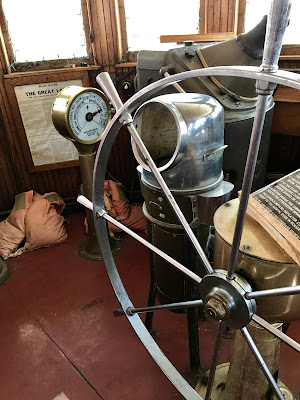This is the last day for our visit in the Sault Ste. Marie area, still in Michigan’s Upper Peninsula. First things first, “Sault” is a french word pronounced “soo” which means fast tumbling waters. The town therefore was named because it is located at the 3 mile long rapids on the St Mary river, the artery connecting Lake Superior and Lake Huron. This makes it critical for Great Lakes shipping. Four locks were built on the river here, one of which can accommodate ships up to 1,000 feet long. We heard that more ore tonnage passes through these locks than all the other locks and canals in the world combined and we understand they are the busiest in the world with over 11,000 passages per year! One more fun fact, passage is totally free.
We saw two ships pass through the locks this holiday weekend. What you are looking at is the 700 foot Canadian ore freighter, Michipicoten, entering the lock system from Lake Huron to Duluth, Minnesota, the most westerly port on Lake Superior. She is a self-unloading ship capable of carrying approximately 11,000 tons with a cargo of what we believe was crushed limestone.
 |
| Entering the locks from Lake Huron |
 |
| Notice ship approaching from Lake Superior, upper left |
|
One of the first things we did once we set up our rig was make the drive over to Tahquamenon Falls. Locals call it “root beer falls,” you can see the brown color of the water and the frothy foam for yourselves. We were told this is the second largest falls east of the Mississippi, second only to Niagra, of course. The area was scenic with many interesting and unique sights.
On another day we made the short drive to the Point Iroquois Light Station with it’s steam powered fog horn, built in 1870 and manned until 1962. We understand that the lake passage from Pictured Rocks to the Soo Locks has the most ship wrecks in the Great Lakes system. This is due: to frequent bad weather; being the deepest and coldest portion of Lake Superior; and, to a large number of ships queuing up to go through the locks.
 |
| This was a two family home as well as the lighthouse |
Yet another day we toured the Great Lakes freighter Valley Camp, a 550 foot decommissioned ore ship. Built in 1917 and now moored on the St Mary river the Valley Camp now functions as a museum. It’s one thing to see these behemoths slowly glide through the lake waters, it’s completely different to board it and climb all over, inside and out, and realize just how big, really big, they actually are! Here are a few shots that don’t do it justice, but give you a general idea.
Remember how I mentioned how many ship wrecks are in this area? One of the exhibits of this floating museum was an homage to the 1975 mysterious sinking of the Edmund Fitzgerald. It may be more familiar if you remember the Gordon Lightfoot song from 1976 by the same name. He immortalized the event in my mind with this musical earworm.
 |
| Actual life boat from the Edmund Fitzgerald |
|
One of the last items we noticed on this quirky but very interesting museum ship were several references to the derivation of interesting terms used in our language. Here is one appropriately placed.
We were also impressed with the many colorful cross walk murals painted on the roads in this town and the large number of wind mills on the Canadian side of the river. We highly recommend this stop if you are in the area.
 |
| After a long day sightseeing... we come home to pure mischief |





























